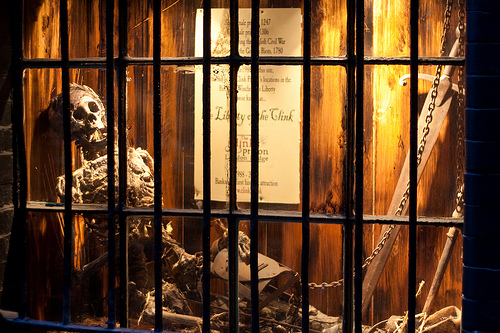The Clink Prison
If you have ever wondered where the phrase ‘in the Clink’ come from, when referring to someone being behind bars it all comes back to the Clink prison. The Clink is probably the oldest prison in the country so it is no wonder that is was use as a term of reference for the majority of the population over the centuries. The Clink Prison was situated in the Southbank area of the city and dates back to 1144. Visitors to the prison museum will be able to not only see, but handle and interact with many of the exhibits that illustrate the prison’s grisly past.

Dark Times
The museum is built upon the site where the original Clink Prison stood and is filled with devices designed to inflict pain and obtain confessions during torture. As well as being able to handle the exhibits visitors here will also be able to hear tales of life within the prison walls and witness for themselves just how dire conditions in the jail were.
The Clink was actually owned by the Bishop of Winchester who used the prison as a means of exerting power and control over the residents of the Southbank area, which was commonly referred to as ‘The Liberty of the Clink’. This part of London was less than savoury and home to a multitude of entertainment venues, some light and theatrical and others dark and dangerous. Within the boundaries of the ‘Liberty of the Clink’ there were at least four theatres, places where bear baiting and bull baiting were carried out, dog fights and cock fights and a whole whose of dark and seedy entertainments.
A Bishop’s Palace
The Clink was not a solitary building; instead it was part of a much larger estate that covered much of the Southbank Area. All of the buildings on this site belonged to the Bishop. Known as Winchester House it was more of a palace than an ecclesiastical building. In fact, so grand was the building that King Henry VIII wanted to take it and have use of it himself. There are still some parts of Winchester House still visible, such as the beautiful and world renowned Rose Arch Window which was part of the great hall of the palace, other parts of the great all also remain. It remains in part thanks to the preservation methods employed by National Heritage. The enormous complex built by the bishop received many a dignitary and famous visitor over the centuries including Geoffrey Chaucer, King Henry VIII and Sir Frances Drake.
Strange Vibrations
With such a long legacy of crime and punishment the site is reputed to be well haunted, and staff and visitors of the site have reported doors opening and closing on their own, glasses smashing of their own accord and figures vanishing into solid walls. If you are willing to walk within its walls you too may pick up on the long and torturous past of this prison, the one prison which gave its name to all others that were to come after it.

